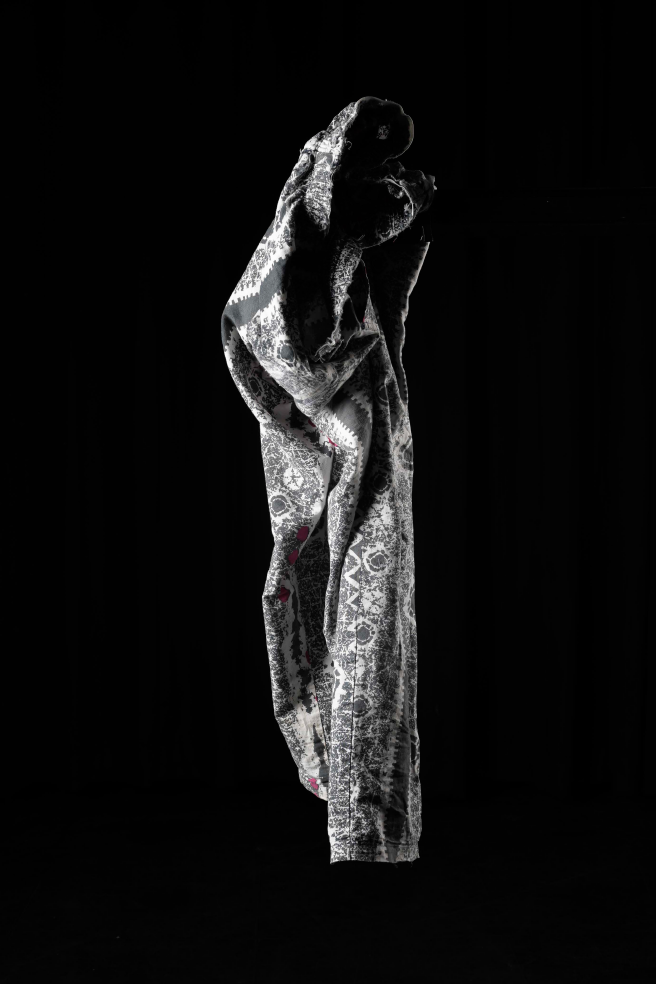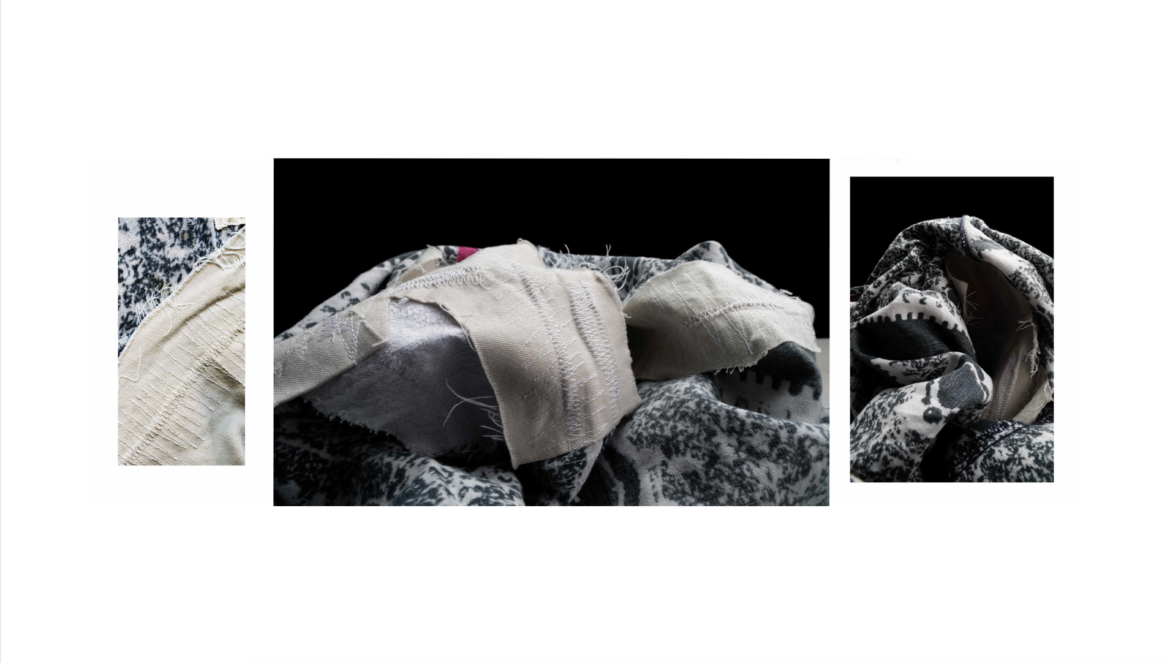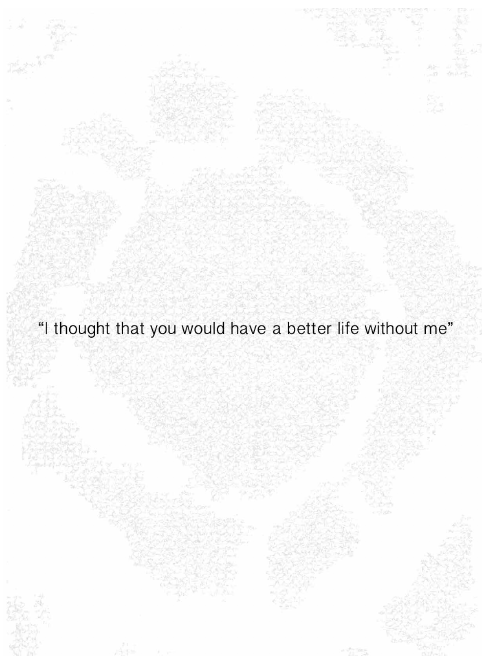Photographs as the Mirror of the Memory and the Oscillation between the Past and Present

The photo series In the Trousers of My Father invites the viewer to examine family snapshots, landscapes, studio shots of trousers and details of the trousers’ fabric pattern in combination with text. Besides the images, the author includes a video in which the final outcome of the series is presented in the form of a tactile object resembling a photo album. This essay will aim to answer the question: what is the relationship between time and representation in this photo series, in connection to the process of memorialization? I will first discuss this relationship in regard to vernacular photographs and their juxtaposition to photographs of trousers. Then, I will reflect on the process of memorialization as depicted in the combination of images from the past and present. Lastly, I will analyze the form of the series as a physical object close to the family album.
The title of the series, In the Trousers of My Father, serves as an explanatory aid for the viewer when looking at the images. The linguist Clive Scott defines this type of title as destination because it provides the observer with a greater understanding of the images through the title’s descriptive nature.[1] Thus, the viewer is informed that the series is about the author’s father and hence adds a personal and subjective element to the work. Without the title, the author’s involvement in the series becomes less clear. However, there is a visual association between a family photograph of an adult man wearing patterned trousers together with separate images of the trousers itself. In order to reflect more on the importance of family photographs in this series, I will turn to photographic theories concerning vernacular photography.
[1] Scott, 1999, 47.
A part of the series consists of ordinary photographs depicting family and friends either at home or outside, resembling photographs from a family album. This type of photography can be identified as vernacular, which is defined by the art historian Geoffrey Batchen as ordinary photographs purchased and created by common people from 1839 onwards. Even though such photographs are typically dear to people’s hearts and often found in their homes, they have been largely excluded from photography exhibits and are rarely seen in museums or academies.[1] The photo series features four vernacular images which suggests the presence of the author and his/her family in the context of both the home and its surrounding environment. The images appear to have been captured in the past as they have a different color filter and style from the rest. Therefore, the assumption is that these few images were not photographed by the author of the series; rather they were captured by someone else (perhaps a family member) in the past. Batchen argues that vernacular photography from the past can evoke a sense of nostalgia, “an illogically warm feeling toward the past, a kind of pleasurable sadness.”[2] Such images from the past can, thus, serve as a commemorative and emotional aspect of the series which can be understood as a motive for including the rest of the photographs in the present. In this sense, vernacular photography can be strongly related to the process of memorialization.
In this process, the position of the viewer is essential as the concepts of time and representation begin to interplay. As Batchen suggests, “memory is generated as an emotional exchange between an evocative image ensemble and a receptive viewer.”[3] Many theorists have underlined photographs’ function as memento mori and particularly the medium’s connection to memory and death. According to the essayist Susan Sontag, all photographs can be understood as memento mori. In her perspective, “to take a photograph is to participate in another person’s (or thing’s) mortality, vulnerability, mutability. Precisely by slicing out this moment and freezing it, all photographs testify to time’s relentless melt.”[4] As such, the use of vernacular photographs creates the impression of the passage of time by showing a moment from the past and through memory stimulation, reminds the spectator of their own finiteness. The film theorist Christian Metz shares a similar opinion with Sontag and states that in all photographs, we can find “this same act of cutting off a piece of space and time, of keeping it unchanged with the world around us continues to change, and of making compromise between conservation and death.”[5] When observing a photograph of a person who is depicted in a particular space and time, it becomes apparent that people in the present occupy a different spatial and temporal position. Consequently, as spectators of this series, we are disconnected from the author’s social reality, specifically regarding when the images of the loved ones were produced and what specific memories they evoke.

Instead, we are presented with a combination of the family photographs with the photographs of trousers, suggesting that the series deals with the conception of time in both the past and present. Through this combination, the viewer can sense a feeling of loss and absence. The vernacular images refer to a moment in the past that is no longer part of the present and hence, they serve as a reminder of those moments and the people depicted within them. On the other hand, the images of the trousers seem to connote the loss of someone that is no longer part of the present, highlighted by the act of photographing an object without the person in the present who was part of the photograph taken in the past. This focus on specific objects, such as trousers, links to Metz’s conception of photography as a fetish. In his text, he discusses photography’s close relationship with death, noting that “the social practice of keeping photographs in memory of loved ones who are no longer alive” helps turn these images into fetish objects.[6] In the case of the series, this notion of the fetish can be connected to vernacular photographs serving as direct memories of loved ones. However, the link is perhaps even stronger in the pictures of the trousers as the trousers itself can be a fetish object and when photographed they become a fetish in the form of an image, thus functioning in the process of memorialization on a meta level.
Aside from the notion of the fetish, the juxtaposition of the photographs also relates to the two terms—“that-has-been” and punctum—coined by the famous literary theorist Roland Barthes. Barthes’ awareness of “that-has-been” can be linked to the perception of reality in a photograph: what I see has been there. “That-has-been” is related to the shock a photograph can provoke and, in contrast to the culturally imposed studium, punctum underlines this unforeseen and irrational reaction.[7] Barthes uses this term in relation to the Winter Garden Photograph[8] which triggered a unique emotion in him by making him alternate between “that-has-been” and “that-will-be”. Thus, when referring back to the series, there is a sense of punctum in the family image of the person wearing the trousers because upon observing the other images, we question why the person is suddenly no longer there. Therefore, the punctum serves as a temporal oscillation in the series and rather than an exact reference of reality, it is shaped by the viewer’s belief of what happened.

In order to further highlight the understanding of time in the series as an oscillation between the past and present, I would like to discuss the use of text pasted on low opacity images depicting a detail of the trousers’ pattern. As Batchen argues, the inclusion of text in the images is a strategy used by the author to augment the images’ memorial power. The sentences allow the images to become livelier and “enhance their capacity to arouse emotions.”[9] The author used direct quotes (assumingly attributed to the father) and placed them in the center of the image. Therefore, this strategy aims to include a trace of the author’s father which strengthens the viewer’s perception of the series as authentic and memorable. Furthermore, the pasted text can be interpreted as a caption which “creates meaning by address, or by a spoken complicity between purveyor and viewer.”[10] In the series, the quotes reveal vague statements relating to an unpleasant event the speaker is not willing to discuss, thereby creating tension between the viewer and the image seen. These particular images guide the viewer throughout the series as they are used at the beginning, middle and end. The text adds context to the series and consequently contributes to its narrative flow which is based on moving in time, from past to present and vice versa. While the low opacity of the images additionally gives rise to the notion of recalling the past, they nevertheless indicate that with time, memories slowly fade away and no longer adhere to reality.
In addition to time, the themes of loss and absence are heightened regarding the concept of representation. The vernacular photography’s indexical nature, and hence its assumed connection to the notion of truth and reality, can be understood as the main stimulant of memory and emotional arousal. As the literary scholar Marianne Hirsch noted, family photographs are a false illusion in that that they are an exact documentation of the real which in effect naturalizes cultural practices in the form of distributing familial myths, hidden behind the assumption that those are actual moments in family history.[11] As a result, family pictures become a space of contestation and that is often the reason why contemporary artists use them and rearrange them in order to search for and present their personal life story and identity in the images.[12] The contestation is visible in the series as the juxtaposition of family photographs from the past and the images of trousers from the present challenge the perception of the series as merely indexical. The visual approach to the images of the trousers is noticeably different from that of the family photographs. Rather, the images of the trousers focus on details, patterns, and structures, subsequently making the images abstract in resemblance to a painting which, in turn, highlights the series’ iconic character. In this sense, the photographs of the trousers itself become objects of contemplation and part of the unreal and imagined, mirroring loss and absence.
At the end of the series, the author includes a web-link re-directing the viewer to a video where a person is showing the series as a tangible object resembling a photo album. The photo albums, like the one featuring this series, are strongly personalized as the author fully determines the design, the sequencing of photographs and the addition of text. As the video reveals, the photographs are enclosed in a hard cover box with a printed pattern of the trousers. When opened, the viewer is presented with folded paper sheets which are later unfolded and consequently reveal the series’ images. Therefore, aside from the visual experience, the work is also meant to be touched which establishes a tangible connection between the viewer and the contents of the box. By having this physical contact with the album, motion and a sense of passing time can be personally experienced which emphasizes the narrative structure of the series. Accordingly, as Batchen proposes, “the photograph is something that can also have volume, opacity, tactility, and a physical presence in the world.”[13] Therefore, in the form of a tangible object resembling a photo album, the series serves as an aid to memory when remembering loved ones and hence further stresses the author’s personal and intimate association with the work.
The aim of this research was to explore the relationship between the photo series and the concepts of time and representation in connection to the process of memorialization. The concepts of vernacular photography, time in photography and loss and absence were also discussed throughout the analysis. The series is related to vernacular photography because it features four family photographs depicting a familial and homely environment. Due to the combination of images from both the past and present, the spectator partakes in the oscillation of time in the series which stresses the importance of memory in the work. Furthermore, through this combination, feelings of loss and absence can be experienced as people are present only in the family photographs, but nowhere else in the series. The sense of absence and loss is further heightened by the photographs of trousers without the father wearing them. The text and final form of the series also play an important role in remembrance as the quotes encourage the viewer to join the author in remembrance of the father while the final form, similar to a photo album, establishes a physical contact with the viewer and further emphasizes the subjectivity and authenticity of the work. As spectators of the series In the Trousers of My Father, we move in time and become part of the process of memorialization as constructed in the series. By the end of flipping through the images, we hope too to be remembered and not completely forgotten.
(All photographs are captured by Peter Pflügler)
[1] Batchen, 2000, 262.
[2] Batchen, 2004, 14.
[3] Batchen, 2004, 97.
[4] Sontag, 2005 [1973], 11.
[5] Metz, 1985, 141.
[6] Metz, 1985, 140.
[7] Barthes, 1980, 41; 77.
[8] The Winter Garden Photograph is a photograph Barthes found a few years after his mother’s death. It depicts his mother when she was five years old together with her brother in Winter Garden. This particular photograph induced in Barthes the feeling of punctum which is very subjective and therefore, might not be shared by others (Barthes, 1980, 67).
[9] Batchen, 2004, 41; 49.
[10] Scott, 1999, 52.
[11] Hirsch, 2012, 7.
[12] Hirsch, 2012, 213-214.
[13] Batchen, 2000, 263.
References
Barthes, Roland. 1980. Camera Lucida: Reflections on Photography. London: Vintage.
Batchen, Geoffrey. 2000. “Vernacular Photographies.” History of Photography 24 (3): 262-71.
Batchen, Geoffrey. 2004. Forget Me Not: Photography & Remembrance. New York: Princeton Architectural.
Hirsch, Marianne. 2012. Family Frames: Photography Narrative and Postmemory. Cambridge, MA: Harvard University Press.
Metz, Christian. 1985. “Photography and Fetish.” October 34: 81-90.
Scott, Clive. 1999. The Spoken Image: Photography and Language. London: Reaktion Books.
Sontag, Susan. 2005 [1973]. On Photography. London: Penguin Books.